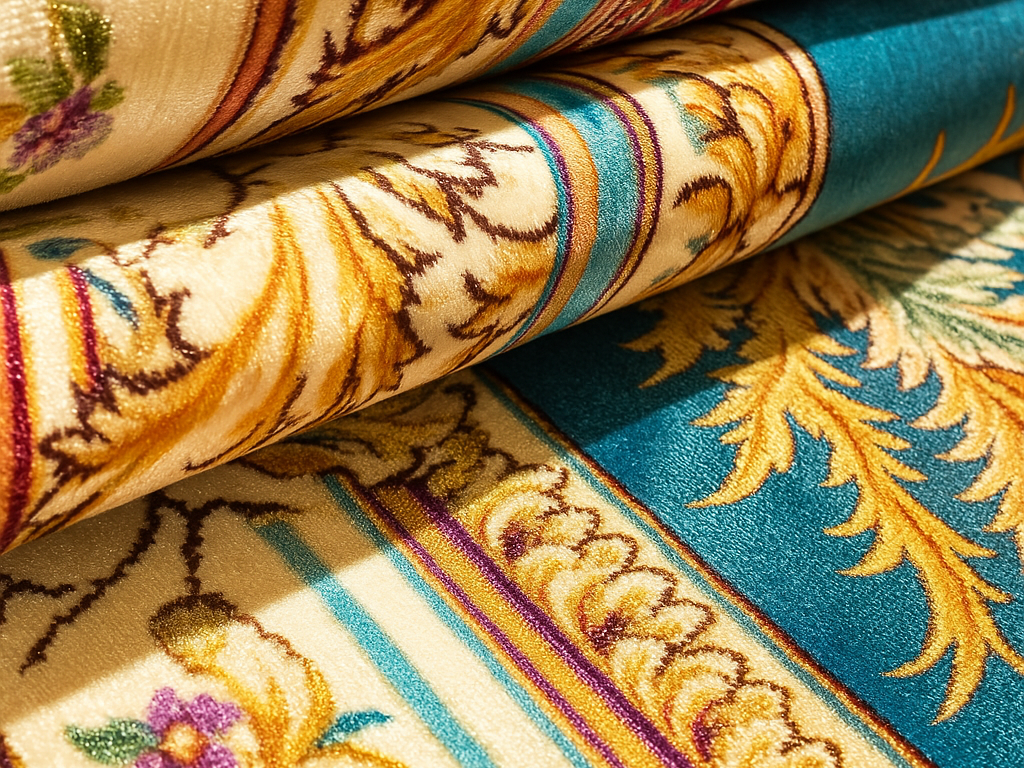Holzböden bringen zeitlose Wärme und Charakter in jeden Raum, aber die Wahl der richtigen Teppichfarbe kann über die Gestaltung Ihrer Inneneinrichtung entscheiden. Das Zusammenspiel von Teppichfarben und Holzuntertönen schafft visuelle Harmonie, definiert Räume und gibt den emotionalen Ton Ihres Raumes vor. Als Bodenbelagsspezialist mit mehr als einem Jahrzehnt Erfahrung habe ich diesen wissenschaftlich fundierten Leitfaden zusammengestellt, um Ihnen die Entscheidungsfindung zu erleichtern.
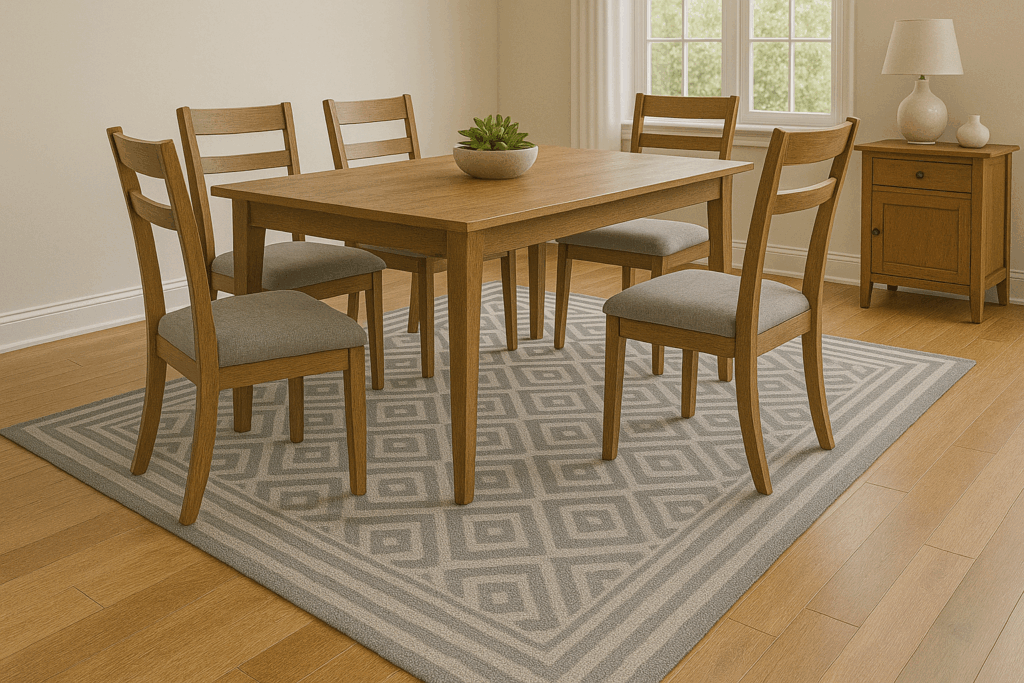
1. Die Untertöne von Holzböden verstehen
Holzböden sind nicht einfach nur "braun" - sie haben subtile Farbnuancen, die die Kombination von Teppichböden beeinflussen. Diese Untertöne zu ignorieren ist der häufigste Fehler von Hausbesitzern.
Warme Untertöne (Gelb, Rot, Orange)

Häufig in Holzarten wie Kirsche, Hickory oder Eiche (einschließlich "Sonoma Oak" und "Belford Oak") zu finden. Diese Böden strahlen Gemütlichkeit aus, können aber mit kühl getönten Teppichen kollidieren. Profi-Tipp: Böden mit warmen Untertönen verstärken die Wirkung der goldenen Stunde des Sonnenlichts, insbesondere in nach Osten ausgerichteten Räumen..
Kühle Untertöne (Grau, Asche, Blond)
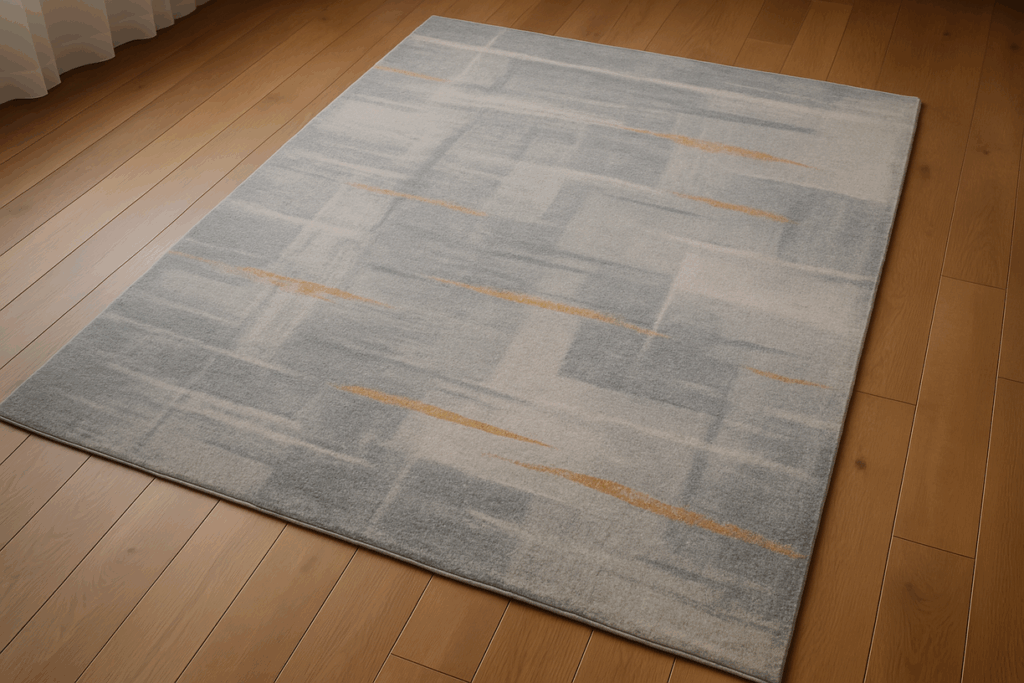
Denken Sie an "Shimo Ash Light", weiß gekalkte Eiche oder Ahorn. Diese Hölzer haben stählerne oder weizenartige Farbtöne, die mit Blau-, Grün- und Grautönen harmonieren. Wissenswertes: Kühle Böden erweitern kleine Räume optisch, indem sie das Licht reflektieren..
Neutrale Untertöne (Echtes Braun, Beige)
Hölzer wie Nussbaum oder "Glacial Northern Red Oak" schaffen ein Gleichgewicht. Sie sind vielseitig verwendbar, aber es ist erforderlich, Teppichmuster unter den Lichtverhältnissen in Ihrem Raum zu testen.
Designer-Einblick: "Machen Sie einen einfachen Test: Legen Sie ein rein weißes Papier neben Ihren Fußboden. Wenn das Holz gelblich aussieht, ist es warm; wenn es aschig erscheint, ist es kühl."
2. Die Wissenschaft der Farbharmonie
Nutzen Sie bewährte Designkonzepte, um die Kohärenz zwischen Ihrem Teppich, Ihren Böden und Ihrem Dekor herzustellen.
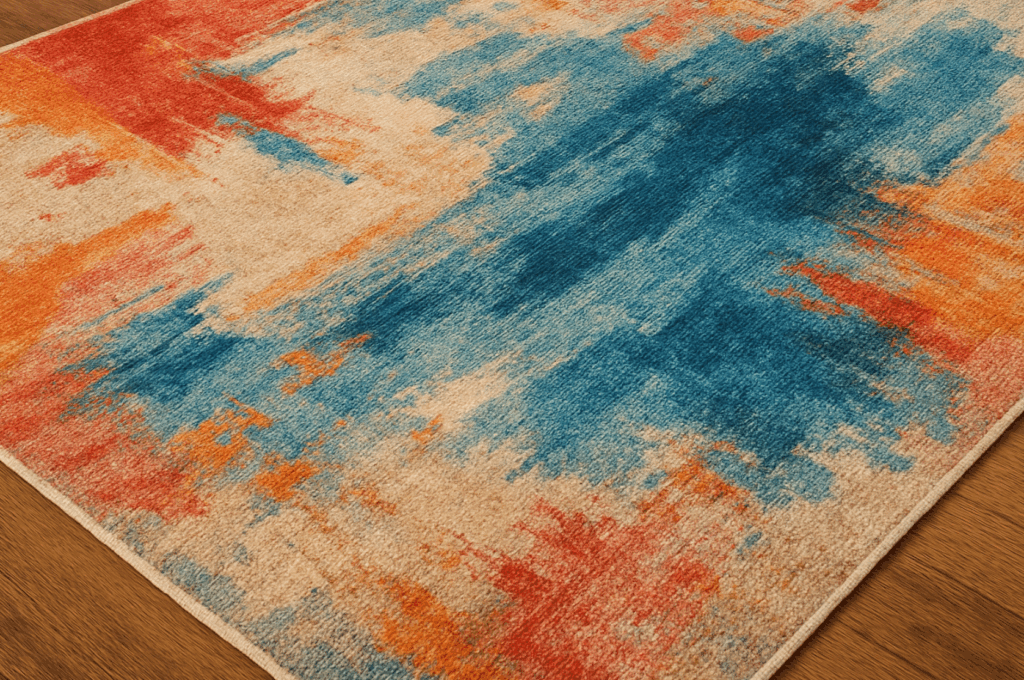
Der Goldene Schnitt 7:2,5:0,5
Diese Grundregel sorgt für ein visuelles Gleichgewicht:
- 70% Hintergrund: Holzböden + Wände.
- 25% "Anker"-Lage: Ihr Teppich + große Möbel.
- 5% Akzente: Wurfkissen, Kunst oder kleine Dekoration.
Ein Teppich, der 25% der Bodenfläche einnimmt, verankert die Möbelgruppen visuell, ohne mit dem Holz zu konkurrieren.
Farbrad-Strategien
- Analoge Harmonie (sicher): Wählen Sie Teppichfarben, die an den vorherrschenden Farbton Ihres Bodens angrenzen. Beispiel: Bei bernsteinfarbener Eiche sollten Sie senfgelbe oder orangefarbene Teppiche wählen.
- Komplementärkontrast (dynamisch): Kombinieren Sie Gegensätze, um Lebendigkeit zu erzeugen. Rote Eichenböden harmonieren mit tealfarbenen oder waldgrünen Teppichen.
- Triadische Balance (fett): Verwenden Sie drei äquidistante Farben (z. B. Braun des Holzes + Blau des Teppichs + Gold des Akzents).
Profi-Tipp: Verwenden Sie in offenen Räumen einen "Übergangsteppich" mit gemischten Farbtönen (z. B. elfenbein- bis anthrazitfarbenes Ombré), um verschiedene Bodenbereiche miteinander zu verbinden.
3. Was sind die besten Teppichfarben für helle Holzfußböden?
Helle Holzböden wie Weißeiche, Birke, Ahorn oder natürlicher Bambus sind für ihre luftige, vielseitige Ästhetik bekannt. Sie hellen Innenräume auf, reflektieren das natürliche Licht wunderschön und bieten eine neutrale Fläche für eine Reihe von Einrichtungsstilen. Aber um einen Raum wirklich zusammenzubringen, ist die Wahl der richtigen Teppichfarbe entscheidend. Ganz gleich, ob Sie sich für skandinavischen Minimalismus oder Küstencharme entscheiden, der Teppich, den Sie wählen, kann den Raum entweder erden oder ihn noch mehr aufwerten.
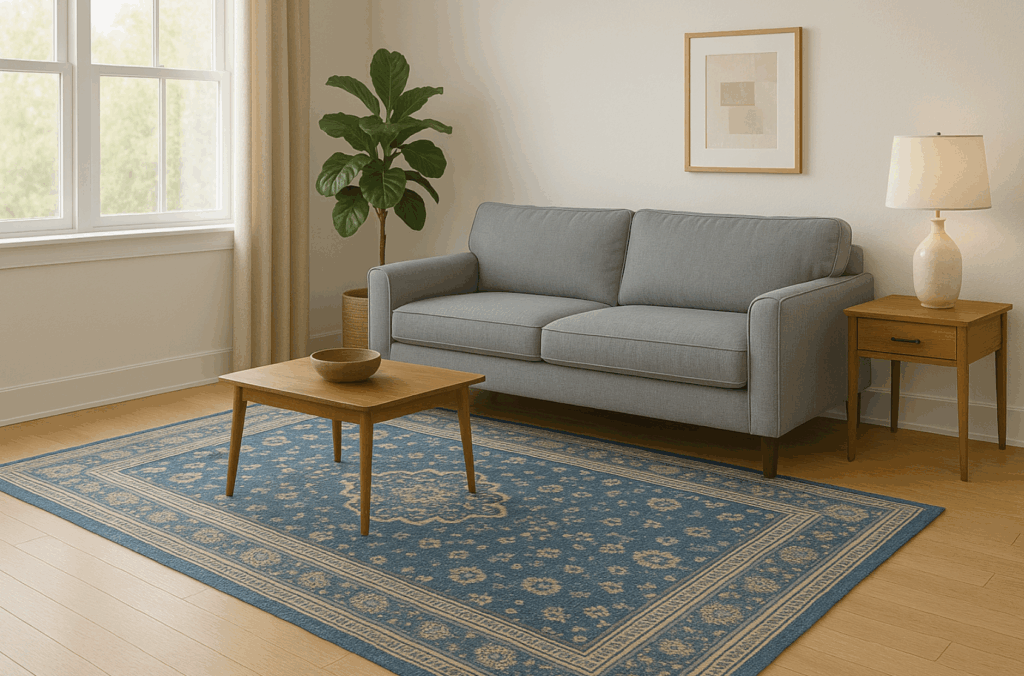
Neutrale Töne: Klassisch und beruhigend
Neutrale Teppichfarben wie Beige, Elfenbein, Creme, Taupe und sanftes Grau sind beliebte Begleiter für helle Holzböden. Diese Farbtöne unterstreichen die natürliche Schönheit des Holzes, ohne es zu übertönen.
- Beige & Sand: Bietet einen subtilen Kontrast und ergänzt die warmen Untertöne von honigfarbenen Ahorn- oder Eichenböden.
- Hellgrau: Sorgt für einen kühlen, modernen Akzent, der besonders gut zu kühleren Hölzern wie Esche oder gebleichter Eiche passt.
- Creme & Elfenbein: Hält den Raum hell, sauber und großzügig - ideal für kleinere Räume oder eine minimalistische Ästhetik.
✅ Am besten für: Skandinavische, bäuerliche, japandische und minimalistische Innenräume.
Pastellfarbene Töne: Sanfte Akzente mit Persönlichkeit
Pastellfarbene Teppiche sind perfekt, wenn Sie Farbe ins Spiel bringen wollen, ohne dass der Raum zu schwer oder zu dunkel wirkt. Sanfte Blautöne, Rosatöne, blasse Lavendeltöne und Mintgrün passen wunderbar zu den Lichtreflexionseigenschaften von Holzböden.
- Puderblau: Bietet ein ruhiges, spaähnliches Gefühl - ideal für Schlafzimmer oder gemütliche Leseecken.
- Erröten Sie Rosa oder Rose Quarz: Verleiht Wärme und subtile Weiblichkeit, ohne zu überdecken.
- Salbei oder Mintgrün: Bringt Frische und eine sanfte Anspielung auf die Natur, die wunderbar mit dem organischen Gefühl von hellem Laubholz harmoniert.
✅ Am besten für: Bohème, Eklektizismus, Shabby Chic und Küsteninterieur.
Kräftige Kontrastfarben: Visuelle Tiefe schaffen
Für diejenigen, die mehr Kontrast und Dramatik suchen, können tiefe Töne wunderbar wirken - solange der Rest der Einrichtung sie ausgleicht.
- Marineblau oder Mitternachtsblau: Verankert einen Raum und bietet gleichzeitig eine klassische Farbpalette.
- Holzkohle oder Schiefergrau: Sorgt in modernen oder industriellen Umgebungen für Definition und Schärfe.
- Schwarz-Weiß-Muster: Auffällig auf hellen Böden, besonders in Kombination mit monochromen oder Mid-Century-Dekoren.
💡 Tipp: Verwenden Sie dunklere Teppiche in größeren Räumen oder offenen Grundrissen, in denen helle Holzböden dominieren und geerdete Elemente benötigen.
✅ Am besten für: Urbane Lofts, Übergangslösungen und moderne Inneneinrichtungen.
Gemusterte Teppiche: Mehr Bewegung und visuelles Interesse
Gemusterte Teppiche sind die Geheimwaffe des Designers für helle Böden. Sie verhindern, dass der Raum flach wirkt und können verschiedene Farben von Möbeln oder Accessoires miteinander verbinden.
- Geometrische Muster: Passt zu modernen und Scandi-Einrichtungen.
- Florale oder persische Motive: Verleiht Charme und traditionelle Eleganz.
- Tribal & Marokkanische Stile: Bringen Sie globale Textur und Wärme ins Spiel.
Halten Sie sich an hellere Grundfarben für den Teppich (wie Elfenbein, Hellbraun oder Grau) und lassen Sie das Muster den Akzent setzen - so wird sichergestellt, dass der Teppich den Raum nicht überwältigt.
Profi-Tipps für die Kombination von Teppichen mit hellen Holzböden
- Textur strategisch einsetzen: Genoppte Wolle, flachgewebte Kelims oder zottelige Berberstile können vor allem in einfarbigen Schemata für taktiles Interesse sorgen.
- Test mit Mustern: Betrachten Sie die Teppichmuster auf Ihrem Boden zu verschiedenen Tageszeiten - Sonnenlicht kann den Farbton des Teppichs stark verändern.
- Schichten Sie es auf: Legen Sie einen farbenfrohen oder gemusterten Teppich über einen größeren Jute- oder Sisalteppich, um dem Ganzen eine Dimension zu verleihen und gleichzeitig ein natürliches Gefühl zu bewahren.
4. Was sind die besten Teppichfarben für dunkle Holzböden?
Dunkle Holzböden - wie Nussbaum, Mahagoni, espressogebeizte Eiche oder Kirsche - vermitteln ein Gefühl von Reichtum und Raffinesse. Ihre tiefen Töne bieten einen dramatischen Hintergrund, der sowohl ein Designvorteil als auch eine Herausforderung sein kann. Die Wahl der richtigen Teppichfarbe ist ausschlaggebend für die Ergänzung oder den Kontrast dieser Böden, um das gewünschte Ambiente in einem Raum zu erzielen.
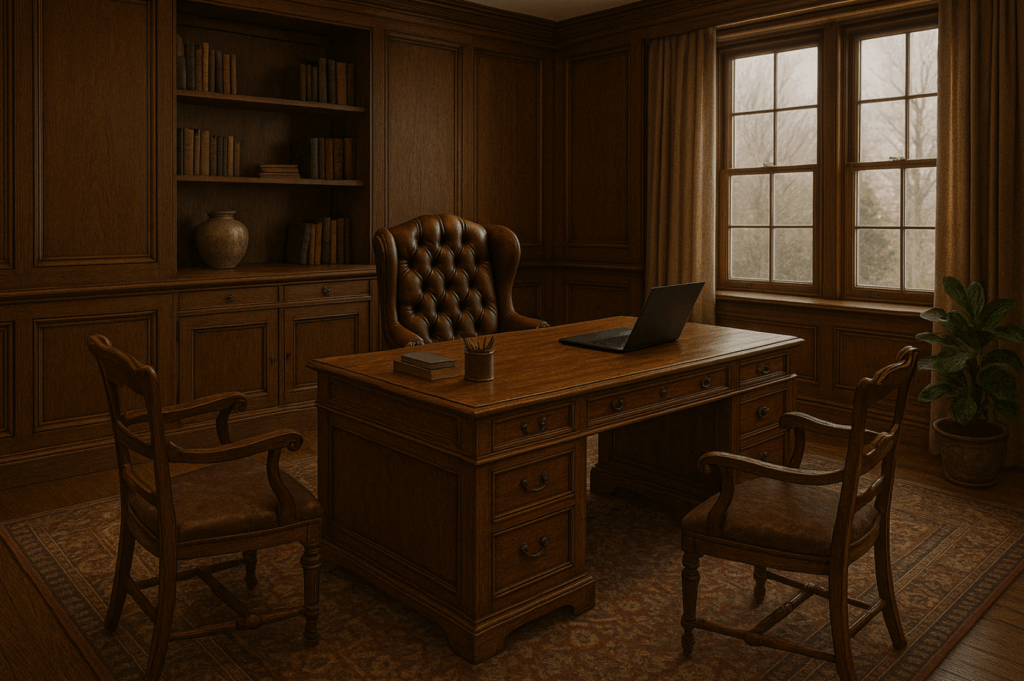
Helle Neutrale: Aufhellen und ausgleichen
Helle Teppiche bilden einen auffälligen Kontrast zu dunklen Holzböden, erhellen den Raum und verhindern, dass er zu schwer wirkt.
- Creme & Elfenbein: Diese Farbtöne bieten einen weichen, warmen Kontrast, der die Eleganz dunkler Böden unterstreicht, ohne den Raum zu erdrücken.
- Hellgrau: Eine vielseitige Wahl, die ein modernes Gefühl vermittelt und die Wärme des Holzes mit seinen kühlen Untertönen ausgleicht.
- Beige & Taupe: Diese neutralen Töne bilden einen subtilen Kontrast und verleihen dem Raum Wärme und Gemütlichkeit.
Helle Neutraltöne sind besonders in kleineren Räumen oder in Bereichen mit wenig natürlichem Licht wirkungsvoll, da sie den Raum offener und luftiger wirken lassen können.
Kräftige Farben: Mehr Tiefe und Dramatik
Die Einführung von kräftigen Teppichfarben kann einem Raum mit dunklen Holzböden Persönlichkeit und Lebendigkeit verleihen.
- Marineblau: Bietet ein klassisches und anspruchsvolles Aussehen, das den Reichtum von dunklem Holz ergänzt.
- Smaragdgrün: Bringt einen Hauch von Luxus und Frische und schafft einen dynamischen Kontrast zum Bodenbelag.
- Tiefrot oder Burgunderrot: Es vermittelt ein Gefühl von Wärme und Tradition und passt gut zu den natürlichen Farbtönen des Holzes.
Diese kräftigen Farbtöne können als Blickfang im Raum dienen, die Aufmerksamkeit auf sich ziehen und dem Gesamtdesign Tiefe verleihen.
Erdige Töne: Mit der Natur harmonieren
Erde-inspiriert Teppichfarben kann in Kombination mit dunklen Holzböden eine kohärente und geerdete Ästhetik schaffen.
- Rost & Terrakotta: Die warmen Farbtöne spiegeln die natürlichen Nuancen des Holzes wider und sorgen für eine gemütliche und einladende Atmosphäre.
- Olive & Salbei Grün: Einen subtilen Kontrast schaffen und gleichzeitig die Verbindung zur Natur aufrechterhalten, um die Ruhe zu fördern.
- Senfgelb: Bringt Farbe ins Spiel, ohne zu aufdringlich zu sein, und unterstreicht die Wärme des Raumes.
Erdtöne sind ideal, um eine rustikale oder böhmische Atmosphäre zu schaffen, die sich nahtlos mit dem organischen Gefühl dunkler Holzböden verbindet.
Muster und Texturen: Verbessern Sie das visuelle Interesse
Die Verwendung von Mustern und Strukturen in Teppichen kann Räumen mit dunklen Holzböden Dimension und Charakter verleihen.
- Geometrische Muster: Bieten ein modernes und strukturiertes Aussehen, das für Kontrast und visuelle Faszination sorgt.
- Florale oder orientalische Muster: Sie verleihen Eleganz und Komplexität und ergänzen traditionelle oder eklektische Innenräume.
- Strukturierte Teppiche: Optionen wie Zottel-, Flecht- oder Webteppiche sorgen für eine interessante Haptik und mildern die Härte des Holzbodens ab.
Achten Sie bei der Auswahl gemusterter oder strukturierter Teppiche auf die Größe und die Farbpalette, um sicherzustellen, dass sie mit dem Gesamtdesign des Raums harmonieren.
5. Faktoren, die bei der Auswahl eines Teppichs zu berücksichtigen sind
Bei der Auswahl des perfekten Teppichs geht es um mehr als nur darum, ein Design auszuwählen, das Ihnen gefällt. Es geht darum, Ästhetik und Funktionalität in Einklang zu bringen, um Ihren Lebensraum zu verschönern. Hier sind die wichtigsten Faktoren, die Sie bei Ihrer Entscheidung unterstützen:
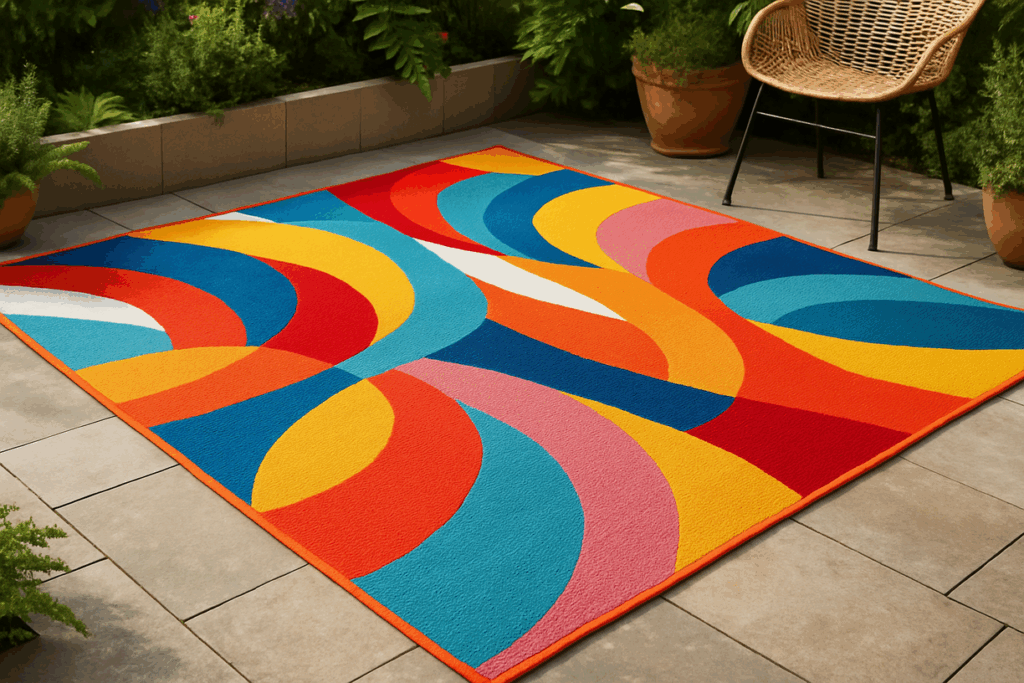
Raumzweck und Verkehr
Berücksichtigen Sie die Funktion des Raums, in dem der Teppich platziert werden soll. In stark frequentierten Bereichen wie Fluren und Wohnzimmern werden strapazierfähige, leicht zu reinigende Teppiche benötigt, während in Schlaf- und Arbeitszimmern weichere, plüschige Varianten verwendet werden können.
Größe und Proportion
Ein Teppich sollte zu den Abmessungen des Raumes und der Einrichtung passen. Unter WohnräumeStellen Sie sicher, dass der Teppich groß genug ist, um unter die Vorderbeine von Sofas und Stühlen zu passen. In Essbereichen sollte der Teppich über den Tisch hinausreichen, um Platz für ausgezogene Stühle zu bieten.
Material und Wartung
Wählen Sie ein Material, das zu Ihrem Lebensstil passt und Wartung Vorlieben:
- Wolle: Langlebig und schmutzabweisend, ideal für stark frequentierte Bereiche.
- Baumwolle: Erschwinglich und leicht zu reinigen, geeignet für Freizeiträume.
- Synthetische Fasern: Fleckenunempfindlich und preisgünstig, ideal für Familien und Haustierbesitzer.
- Naturfasern (Jute, Sisal): Umweltfreundlich mit strukturiertem Aussehen, am besten für Bereiche mit geringer Feuchtigkeit geeignet.
Stil und Design
Das Design des Teppichs sollte mit der Ästhetik Ihres Zimmers übereinstimmen:
- Traditionell: Verschlungene Muster und satte Farben.
- Modern: Klare Linien und minimalistisches Design.
- Böhmisch: Eklektische Muster und leuchtende Farben.
Farbe und Muster
Die Farbe kann die Atmosphäre eines Raumes beeinflussen:
- Helle Farben: Die Räume werden größer und offener.
- Dunkle Farben: Für Wärme und Gemütlichkeit.
Muster können Flecken kaschieren und für visuelles Interesse sorgen. Wählen Sie Muster, die den Maßstab und den Stil Ihres Zimmers ergänzen.
Florhöhe und Textur
Die Pfahlhöhe beeinflusst sowohl den Komfort als auch die Pflege:
- Niederflorig: Langlebig und leicht zu reinigen, geeignet für stark frequentierte Bereiche.
- Mittelhoher Flor: Bietet ein Gleichgewicht zwischen Komfort und Pflege.
- Hochflor (Shag): Luxuriöses Gefühl, am besten für wenig frequentierte Bereiche.
Textur verleiht Tiefe; je nach Vorliebe sollten Sie Schlingen- oder Schnittflor in Betracht ziehen.
Haushalt
Teppiche gibt es in verschiedenen Preisklassen. Legen Sie Ihr Budget im Voraus fest und berücksichtigen Sie dabei Faktoren wie Material, Größe und Verarbeitung. Denken Sie daran, dass ein höherer Anschaffungspreis eine bessere Langlebigkeit und Haltbarkeit bedeuten kann.
Teppich-Pads
Eine Teppichunterlage erhöht den Komfort, verhindert das Ausrutschen und verlängert die Lebensdauer des Teppichs. Besonders wichtig ist sie auf Hartholzböden, um Kratzer zu vermeiden und die Sicherheit zu gewährleisten.
6. Schlussfolgerung
Bei der Auswahl der richtigen Teppichfarbe für Ihre Holzböden müssen Sie Untertöne und Farbharmonie verstehen und verschiedene praktische Faktoren berücksichtigen. Durch eine durchdachte Kombination dieser Elemente können Sie die Schönheit Ihrer Böden unterstreichen und einen zusammenhängenden, einladenden Raum schaffen.
7. FAQs
F1: Kann ich einen dunklen Teppich auf dunklen Holzböden verwenden?
Ja, aber achten Sie darauf, dass es einen Kontrast durch Muster oder hellere Akzente gibt, damit der Raum nicht zu schwer wirkt.
F2: Sind gemusterte Teppiche für Holzböden geeignet?
Ganz genau. Muster können visuelles Interesse wecken und helfen, verschiedene Elemente im Raum miteinander zu verbinden.
F3: Wie kann ich einen Teppich mit meinen Möbeln kombinieren?
Wählen Sie Teppichfarben, die Ihre Möbel ergänzen oder kontrastieren, und berücksichtigen Sie dabei sowohl Farbe als auch Stil für ein harmonisches Aussehen.
F4: Sollte die Größe des Teppichs die Farbwahl beeinflussen?
Ja. Größere Teppiche in kräftigen Farben können einen Raum dominieren, während kleinere Teppiche in dezenten Farbtönen bestimmte Bereiche betonen können.
F5: Ist es in Ordnung, Teppiche auf Holzböden zu verlegen?
Ja. Ein übereinanderliegender Teppich kann Tiefe und Struktur verleihen, aber achten Sie darauf, dass der darunter liegende Teppich den Holzboden nicht beschädigt.

